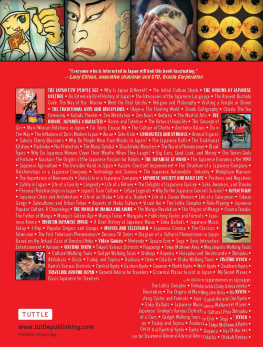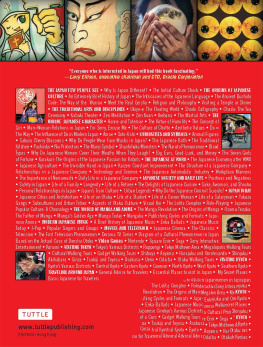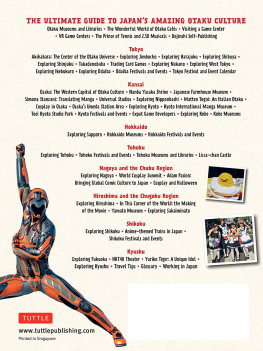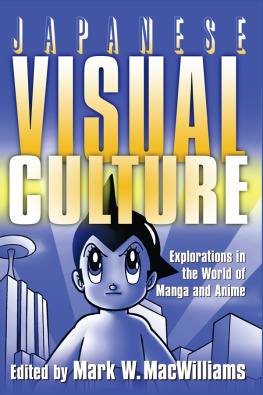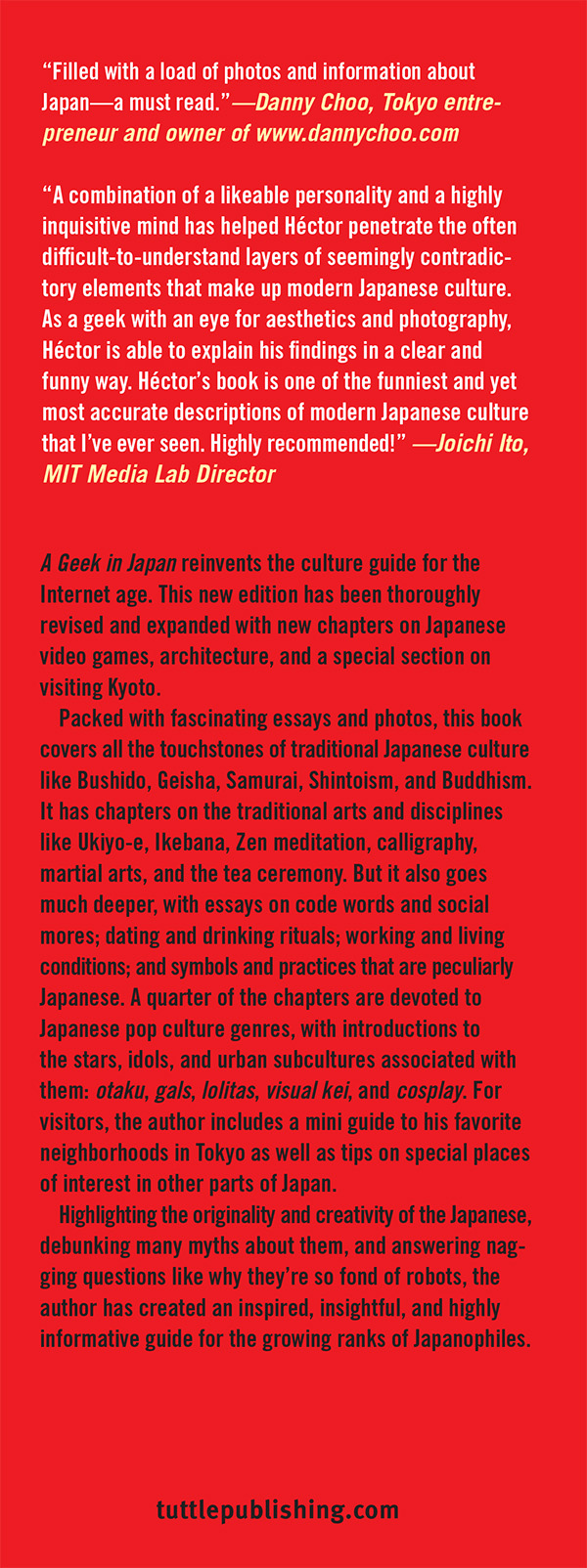


A geek in
JAPAN
by HCTOR GARCA (Kirai)


THE JAPAN FEW PEOPLE SEE
For centuries, Japanese culture has fascinated the world as something mysterious and remote. In classifications made by anthropologists, Japans culture and that of other Asian countries are usually perceived as distinct: the Land of the Rising Sun has its own personality. Japan is also completely different from the West. Its like living in an alien country, and adjusting to life here is no easy matter. Even the smallest detail can be strange and fascinating at the same time. Japans people have been able to preserve their past while adapting to new times and have turned their country into a worldwide financial and cultural leader. I am one of those people who feel passionate about Japan, so I set off for it with loads of questions, seeking answers. Living, studying, and working in this archipelago helped me gradually to understand the country, its people, its companies, its technology, its culture, its way of thinking, and so forth. I decided to write about it on the Internet, so I could share my experience of discovery and new understanding step by step, as I lived it every day. With this aim, I created a blog, www.ageekinjapan.com, A Geek in Japan, where I continue to post as I learn and discover new things.
My blog became something of a phenomenon thanks to the enormous interest elicited by the unknown, for Japan has hardly any presence in Western media, despite being for decades the second largest economy in the world. Why doesnt it appear in the news very often? Well begin to appreciate why through our journey in this book. Well see that the Japanese are naturally reserved and dont like standing out. How many Japanese public figures can you name? But if we rarely see Japan in the media, its always present in our daily lives. Every electronic device you use, your computers, phones, cars, trains, airplanesJapanese technology is inside them. Japan is inside them! How have they managed to spread their creations all over the world in such a discreet, harmonious way, with us barely noticing? In this book, I try to sort out the keys to Japanese culture, the way of life of its inhabitants, the business culture of its companies, and its influence on the rest of the world. Well find out what the Japanese are like, how they think, how we should relate to them. Well learn about the origins of manga, anime, martial arts, Zen meditation, and other elements of Japanese culture that have reached the West, sparking great interest and passion.
You can read this book in two ways: by skipping around and reading those chapters that interest you most, or sequentially. I would recommend reading straight through, since some points are supported by concepts explained in earlier chapters and cant be fully grasped without them. But above all, enjoy the book. I hope it will help you better understand Japan and its peoples way of being. Of course, the ideal ending for this book would be a trip to Japan. So I encourage all of you to come here and enter a world completely different from the West. Its an experience youll never forget.
GEEK
Normally used to refer to enthusiasts who want to know as much as they can about the latest in technology. However, a broader definition might be: a person fascinated by learning and discovering new things. A geek in Japan would then be something like: a person fascinated by Japan and with learning and discovering all about its culture and traditions.

Hctor Garca Puigcerver

Ramen restaurants are among the best places to restore your energy. Cheap and good!

Delivering food by bicycle in the Gion district of Kyoto.

The graceful way past and future merge is one of the beauties of Japan.
WHY IS JAPAN DIFFERENT?
History and geography have been enormously important in defining the different cultures that coexist in the world. As far as Japan is concerned, the fact that it is an archipelago is fundamental. The history of Japan and the shaping of its present-day culture might be summarized briefly in three points that you should bear in mind as you read this book:
1. The great influence of China, source of the character system used in the Japanese language, its religions, and, historically, its system of governance.
2. Japan was closed to the outside world for centuries by dint of a law forbidding foreigners to enter and Japanese to leave. This period of isolation, known as the Edo Period (16031868), was fertile for the creation of indigenous Japanese traditions, such as kabuki, geisha, and ukiyo-e.
3. After the Edo Period, Japan became an imperialist power that came to a dramatic end with the countrys defeat in World War II. When it recovered, it rapidly became the worlds second largest economy.
Besides history, another essential element in defining a peoples culture and their way of thinking is language. Japanese is a language with three alphabets, different levels of formality, and connotations that make it quite different from Western languages. Many words that are part of their way of life and value system are said to be impossible to translate. Over the course of this book, we will try to explain many of these key words. Once we have grasped them, we will have a good general view of how the Japanese think and how we ourselves should behave in their world.

THE INITIAL CULTURE SHOCK
When I boarded the plane for Tokyo, I could already feel how things were starting to shift. Obviously, the plane was full of Japanese people, who besides being different from us physically are also very distinct in their manner. Silence reigned, and in the quiet I noticed the first small details of a certain Japanese style. For example, most of them removed their shoes as soon as they sat down.
Japanese flight attendants also behave differently. They provide our first experience of how the Japanese treat their customers. You feel extremely well cared for, as if you were a king or a god. For the Japanese, customers are very important, they are addressed in highly formal language, attention is paid to them at all times, and they are greeted and seen off with bows. In the plane, we have the opportunity to taste Japanese food and practice with chopsticks. And we can look at printed Japanese in the newspapers that are offered to us. Though we may not understand the language, we can see how different or similar the newspapers are to our own. For example, the sports section shows how much they like baseball, a sport that became popular in Japan due to the influence of the United States. Horse racing is another sport that fascinates the Japanese and is well covered in the media. Finally, a detail that caught my eye was that, instead of having a crossword puzzle or chess problem in the puzzles section, Japanese newspapers have
Next page
